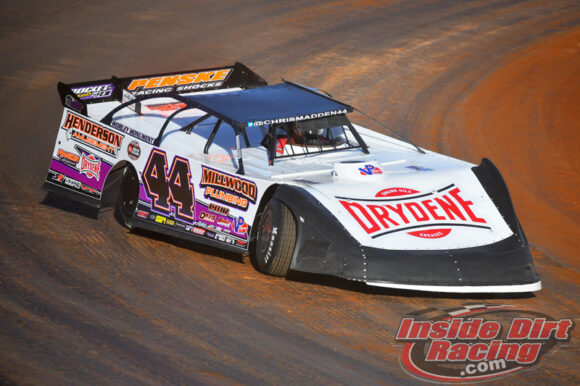*Turn 2 Blog is a regular feature on InsideDirtRacing.com. Here, site operators Michael Moats and Richard Allen take turns offering their thoughts on the dirt racing topics of the day from east Tennessee and beyond.
The latest edition of the Turn 2 Blog is presented by the American Crate All-Star Series.
Richard: This weekend illustrated a point that I think, if the rumors out there are to be believed, a number of the top Dirt Late Model teams are having to take into consideration.
Over the past several years, running one of the two national tours has been the goal of many who participate in this form of motorsports. Not only was the biggest money in terms of feature payouts and end-of-season points funds available for those who ran full-time on either the Lucas Oil Late Model Dirt Series or the World of Outlaws Morton Buildings Late Model Series but there also a level of prestige in taking on that task that allowed for certain degree of bragging rights within the racing community.
But this past weekend’s Peach State Classic at the Senoia(GA) Raceway and the Karl Chevrolet Duel in the Desert at the Las Vegas Motor Speedway showed that there is now money and prestige apart from national series racing. In particular, the money was great at both of those events and both also offered multi-night shows which meant teams were not having to leave one facility after the first night of racing to drive three or four hours to get to the next night’s race.
Chris Madden collected $52,052 from the Senoia race on Saturday night but that had been preceded by Kyle Bronson earning a $10,000 check the night before. At the same time on the other side of the country, Bobby Pierce was awarded $100,000 for his win in Las Vegas which was double the advertised payout after he was rewarded for having perfect attendance at all of the raceXR events this year. Jonathan Davenport had won the Friday feature in ‘Sin City’ to collect $25,000.
We already know that raceXR has big plans for 2022, particularly with multiple race nights on the schedule at Bristol Motor Speedway that will offer large payouts along with a big points fund reward for the champion of that mini-series. They also plan a return of the Colossal 100 for ‘The Dirt Track at Charlotte’ next May. And of course, races such as the Dirt Late Model Dream and the World 100 at Eldora Speedway do not fall under the sanction of either of the national tours.
Brandon Overton and, to some degree, Jonathan Davenport have shown this year that following a series is not necessarily essential to a race team’s financial success. Granted, not everyone is going to win at the rate those two drivers have in 2021, but again, they have shown that it can be done.
So my question is, why follow a series when money can be made, and in some cases, travel expenses can be reduced by not doing so?
It seems as if both the Lucas Oil Series and the WoO Late Models might have seen this coming as more money has been added to their points and feature payouts along with more two-day shows in the same location have made their way onto those schedules. But aside from the “show up” money some series offer to their regular competitors, why stick with a series?
Is this going to become more of the norm for the big stars in the sport?

The Bristol Dirt Nationals were not sanctioned by either national tour but drew stars like Brandon Overton and Bobby Pierce
Michael: It seems like this is part of a cycle we see in the sport. Going back 20 years ago, most top drivers did not follow a series. They chased the money, wherever that was. You saw a lot of big-money, two-day weekends. But in those races, the first night was simply qualifying and heat races and the second night was consolation races and a 100-lap feature. Along the way, teams and drivers wanted to race for more money on those weekends. The two-day show was replaced by the format you mentioned, race at one track on a Friday night and race at another track on a Saturday night.
Now, there’s a push to have actual races on the preliminary nights and a race for a huge purse on the final night. This is good as long as the promoter’s have the money to pay out these purses. As you said, it saves on extra travel.
As far as the drivers, once many of these marquee events started being sanctioned by one of the two series, we started seeing more drivers interested in running one series or the other. Plus, there was a bit of prestige for a driver to say he’s an actual professional racer by following one of those tours. It looks like the drivers that know they are capable of making any race at any track, and competing for wins in these races, are saying they don’t need to follow a series to guarantee themselves a starting spot.
Richard: You’re definitely right that when the national tours began to take in the crown jewels and other big races it added prestige to being a touring driver. And more, there is the obvious benefit of, as you mentioned, of being assured of making the feature by way of provisional for the regulars. But as Brandon Overton and even Kyle Larson have demonstrated this season, if a driver and car are good enough, they are going to make the show without the provisional.
Another reason I think some are starting to realize as a benefit for following certain bigger races rather than a tour is that of being more in control of your own schedule. If a driver follows a series, his team has to go wherever that series has a race scheduled. So even if there is an event paying $15,000-to-win within a couple of hours of the shop, that team may find itself travelling hundreds of miles further to get to a race with a similar payout.
And as we saw this year on more than one occasion, teams drove long distances only to see races cancelled by weather. Not only is that frustrating but it is also expensive.
Control of one’s own schedule might be something teams are becoming more and more interested in, isn’t it?
Michael: I know there was a lot of frustration this past season over some of the logistics with the two series’ schedules. Going long distances only to get rained out and making long trips to another part of the country on several occasions when those could have been condensed into one trip were some of the things I heard from drivers and team owners throughout the summer.
With the price of fuel heading upward and all those big payout races by other groups such as XR, it’s going to be interesting to see who does what when next season starts in February. And even then, it may be April before decisions are ultimately made.
Richard: Along the line of big payouts, it seems as if we are starting to see more and more tracks jumping into the mix in terms of offering purses that pay their winners as much as $50,000. Just this weekend the dirt track located adjacent to the Las Vegas Motor Speedway staged the ‘Duel in the Desert’ weekend that offered $25,000 on Friday night and $50,000 on Saturday. Georgia’s Senoia Raceway also got into the mix with the Peach State Classic that doled out $10,000 on Friday and $52,052 on Saturday.
Numerous drivers stated their appreciation to those tracks for providing such payouts this late in the year.
It seems that much of this is being driven by the various streaming services as they each work to provide content that will make their subscriptions worth the price for the consumers. If fans are going to be asked to pay for multiple services, they have to be able to see value in those services. I’m sure the racers don’t mind, especially those who are collecting the biggest checks.
Either way, as we have discussed throughout this piece, the number of big payouts in Dirt Late Model racing is increasing. The real question is whether or not this model will be sustainable.
Michael: That’s the big question. The crowds at Las Vegas were relatively small in the stands. I don’t know what their pit gate was like and no one will ever know how many pay-per-view subscriptions they sold for the event. Senoia had a huge crowd and a big pit gate. I would think that race was the more successful of the two as far as being a money-maker. If the promoters are successful, these events will continue. If not, they’ll go away and someone else will try to fill the void.
Respond to this post on Twitter by following @RichardAllenIDR and @MichaelRMoats or by liking the InsideDirtRacing.com Facebook page.
Also, NASCAR and pavement racing fans can check out InsideCircleTrack.







